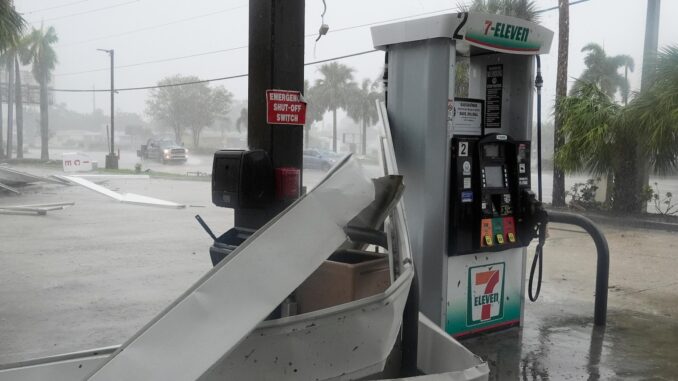
Dozens of tornadoes spawned by Hurricane Milton caught many Floridians by surprise as they braced for heavy rain, strong winds and especially storm surges. Violent twisters were seen crossing highways, ripping off roofs and downing trees and power lines.
There have been 38 preliminary eyewitness reports of tornadoes since Wednesday night, according to the National Oceanic and Atmospheric Administration Storm Prediction Center. Florida sees 50 tornadoes on average total in a whole year. The number confirmed is expected to rise over the coming days as damaged sites are assessed.
The eyewitness reports came as the National Weather Service issued 126 tornado warnings yesterday in the state.
“Certainly that will be a notable part of this storm, was how many tornadoes occurred within such a short period,” said Matthew Elliott, warning coordination meteorologist at the Storm Prediction Center.
The twisters’ ferocity was also unusual.
“It’s definitely out of the ordinary,” said Northern Illinois University meteorology professor Victor Gensini. “Hurricanes do produce tornadoes, but they’re usually weak. What we saw today was much closer to what we see in the Great Plains in the spring.”
Conditions for breeding tornadoes were particularly favorable. Hurricane Milton spent the day offshore with warmth from the sun and instability in the atmosphere creating the right environment.
Tornadoes spawned by hurricanes and tropical storms most often occur in the right-front quadrant of the storm, but sometimes they can also take place near the storm’s eyewall, according to NOAA. The heat and humidity present in the atmosphere during such storms and changes in wind direction or speed with height, known as wind shear, contribute to their likelihood.
“There’s an incredible amount of swirling going on,” Gensini said of the conditions that allowed for the twisters to grow. “Those tornadoes were just in a very favorable environment.”
Earlier this year, Hurricane Beryl spawned 65 confirmed tornadoes, across several states. The most ever caused by a hurricane was 118 from Ivan in 2004. The difference is the tornadoes from Milton all came in Florida and over just eight to 10 hours.
Teasing apart the the damage caused specifically by Milton’s tornadoes could be complicated, but scientists say keeping accurate records of tornadoes is important.
Tornado trends can be grouped into three separate seasons: spring, typical cyclone season, and late fall and winter. “It really goes to show that tornadoes can be a significant part of a tropical cyclone, in this case, a Category three hurricane,” Elliot said.
The warming of the oceans by climate change is making hurricanes more intense, but Gensini said he did not know of any connection between human-caused warming and the deadly tornadoes that Floridians experienced with Milton.
Videos posted to Reddit and other social media sites showed large funnel clouds over neighborhoods in Palm Beach County and elsewhere in the state.
Deaths were reported in St. Lucie County on Florida’s Atlantic Coast, but local authorities did not specify how many residents had been killed.
Florida has more tornadoes per square mile than any other state. But they’re usually not as severe as those in Midwest and Plains. However, a big outburst of powerful twisters killed 42 people and injured over 260 in Central Florida in the space of a few hours in February 1998.
___
The Associated Press’ climate and environmental coverage receives financial support from multiple private foundations. AP is solely responsible for all content. Find AP’s standards for working with philanthropies, a list of supporters and funded coverage areas at AP.org.


Be the first to comment